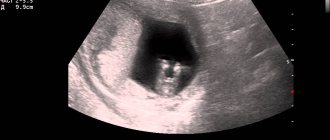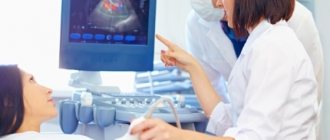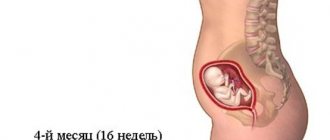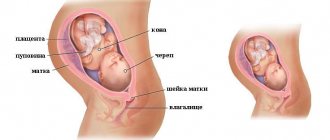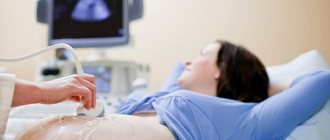Pregnancy is a difficult period in the life of any woman. It is accompanied not only by serious changes in the fetus inside the womb, but also by changes in the body of the expectant mother. That is why it is very important to monitor the course of pregnancy at every stage, including at 18 (20 obstetric) weeks. An ultrasound procedure can greatly help with this.
Why and to whom is examination recommended?
In our country, a pregnant woman has the right to undergo preventive ultrasound examinations three times during her entire period. An ultrasound at 17 weeks, as well as at 18, is usually the second one and is one of the necessary measures.
At this stage, the development of the fetus is usually assessed, its sex is determined, and the data obtained are compared with normal samples. The doctor also needs to study and determine the position of the unborn child in the uterus and the health of the mother’s organs.
Important! If any pathologies are detected (or you are at risk), the doctor may prescribe several other procedures and tests to get a full picture.
Preparation for the procedure
If there are no additional indications from the doctor, the expectant mother does not need to carefully prepare for the study. 2-3 days before the ultrasound, you should switch to a light diet, excluding fatty and spicy foods, as well as foods that cause increased gas formation. Following such a menu will prevent the appearance of flatulence in the intestines and allow the specialist to obtain clearer images of the fetus, which contributes to the maximum information content of the study results.
It is recommended to empty the bladder and have a light snack 20-30 minutes before the ultrasound. To stimulate fetal activity, you can eat a product containing carbohydrates, such as candy or a piece of chocolate. Invigorated by the sweetness, the child will actively twirl, allowing the specialist to take the necessary measurements and even determine the gender.
Mother's condition and fetal development
During this period of time, as a rule, the woman’s condition and well-being normalizes and stabilizes. Toxicosis and unpleasant sensations are completed by this stage, and the stomach is not yet very noticeable and can be hidden under clothing. However, back pain may begin due to weight gain, which usually gets worse towards the end of pregnancy.
A child at 18 weeks already has mostly formed organs and body parts, so he looks quite proportionate and complete.
Ailments during pregnancy
Dyspnea
Even with little physical activity, it can bother the expectant mother. The reasons for this condition are different. In most cases, shortness of breath is associated with physiological causes. During pregnancy, a woman's body begins to rebuild to maintain the viability of the mother and fetus. Thus, the volume of circulating blood becomes larger, and the cardiovascular system begins to work at an accelerated pace, activating metabolic processes, which leads to shortness of breath.
For an accurate diagnosis, it is better to visit a doctor and, if necessary, be examined.
Heartburn
Heartburn appears due to the displacement of the abdominal organs upward towards the diaphragm. This displacement is caused by an enlarged uterus.
To prevent heartburn, it is advised not to take a horizontal position immediately after eating. At one time, the volume of food should not be more than 200 ml. It is advised to cope with heartburn with the help of sunflower seeds.
Epigastric pain
The cause of such pain is also an enlargement of the uterus, which entails displacement of the internal organs. They may be noticeable before and after eating. Diet will help cope with this problem. It is also advised to monitor bowel movements.
Pain and cramps in the leg muscles
Due to weight gain and increased blood volume, the load on the lower limbs increases. A lack of microelements can cause muscle cramps. Control your walking time, and raise your legs up while resting. If necessary, it is better to consult a doctor.
Pathological vaginal discharge
Pay attention to the amount of discharge; if it increases or you feel an unpleasant odor, contact your gynecologist. The specialist will assess the situation, determine whether there are signs of inflammation or infection, as well as the motor activity of the fetus and its condition.
Dizziness
If such a problem occurs in isolated cases, then it is not dangerous. And in case of frequent manifestations, you should consult a doctor.
What do they look at in the study?
Using this procedure, you can determine the main changes in the fetus. Typically at this stage:
- the body is proportionally developed, the primary organs are formed;
- the visual and auditory systems are developed so much that the child can use them;
- the immune system is laid down;
- the primary rudiments of milk and molars appeared.
If the child develops abnormally in the womb, the following may be detected:
- development too fast or too slow;
- abnormalities of the nervous system and skeletal bones;
- pathologies of blood vessels, heart and other internal organs;
- genetic and chromosomal pathologies.
The amount of amniotic fluid and possible deviations of the pregnant woman’s internal organs are also determined. In this way, the presence of possible infections and other abnormalities can be detected.
Recommendations
Just as in previous stages, pregnant women are recommended to get proper rest, proper nutrition, and a positive attitude.
Pregnant women CAN :
- do light gymnastics;
- take walks in nature with family and friends;
- go to water aerobics for pregnant women;
- have sex (if there is no restriction from the doctor);
- do what you love (reading books, embroidering);
- have a full rest.
Pregnant women CANNOT :
- smoke;
- eat fatty foods and foods with concentrates;
- engage in intense physical activity;
- take medications without consulting a doctor;
- drink strong coffee, tea.
Vitamins
Vitamins are very important for a pregnant woman’s body; they are necessary for the health of the mother and the proper development of the baby. With a lack of vitamins, various pathologies can develop.
List of essential vitamins for pregnant women:
- Folic acid . Affects the hematopoietic systems and their development, reduces the risk of the formation of pathologies in the child’s brain. Contained in liver, red fish, cereals;
- B vitamins . They affect metabolic processes, absorption of nutrients, and the development of the baby’s endocrine, cardiovascular, immune, and nervous systems. Contained in fish, dairy products, vegetables, cereals, legumes;
- Vitamin E (tocopherol) . It is an antioxidant, protects against toxins, and takes part in metabolism. Contained in butter, milk, eggs;
- Vitamin D. Promotes the proper formation of bones, teeth, muscles, and helps the absorption of calcium. Enters the body with fish, caviar, egg yolk;
- Vitamin A . Helps to develop the visual apparatus, strengthens the protective properties of mucous membranes and skin. The maximum amount of it is in fish oil, eggs, parsley, liver. Other beneficial substances are also very important for the body of pregnant women: calcium, magnesium, phosphorus, potassium, copper, chromium, iron, zinc.
Nutrition
Nutrition is a very important issue during pregnancy. Many pregnant women underestimate its importance for their health. The development of the baby in the womb also depends on the mother’s nutrition.
A pregnant woman's diet should be balanced and include healthy, varied foods:
- fruits and vegetables;
- porridge, especially buckwheat;
- lean fish;
- dairy products;
- eggs, greens, beans;
- juices (tomato and apple).
A woman who adheres to proper nutrition may not worry about the lack of nutrients in her body. But you will have to give up strong coffee and alcohol.
Physical activity
At 18 weeks of pregnancy, the woman’s body is finally filled with energy and full of strength:
- Walk more and your body will thank you for being active.
- Stretching, exercises for the abdomen and back are recommended.
- You can do yoga or swimming.
Remember that there are restrictions: do not strain your abdominal muscles, do not jump.
Photo of the fetus
In the photo you can easily see:
- placenta, umbilical cord, uterus;
- neck;
- veins on the back of the fetal head;
- formed arms, legs, some muscles, fingers;
- ears, nose.
Good equipment will allow you to see the practically formed genitals of the child on the monitor and in the picture. The labia of a girl and the penis and testicles of a boy can be clearly seen.
Reference! With a hundred percent probability, gender can be determined at a later date. Also, accuracy can greatly depend on the position of the child, the angle, and the quality of the equipment.
boy
Girls
Normal indicators
During the procedure, it is very important to note the ultrasound indicators of the fetus and compare them with the reference ones. The doctor carefully examines all the baby’s organs, focusing on the size of the fetus.
A sample typically has the following parameters:
- body length - about 13-15 centimeters;
- head circumference – from 131 to 161 millimeters;
- length of the humerus - from 19 to 31 millimeters;
- thigh bone length – from 18 to 32 millimeters;
- fronto-occipital length - from 43 to 64 millimeters;
- abdominal circumference – from 104 to 144 millimeters.
It is also important to take your heart rate into account. Normally it should be from 140 to 160 beats .
Important! Minor deviations of a few millimeters cannot be called pathology. However, the heart rate should only be within the established limits.
Fruit size
At this stage, the coccyx-parietal size (CPR) is about 200 millimeters.
In addition, in some cases, the length of the cervix is measured, which should be at least 28 millimeters. But for this you need to undergo an examination with a vaginal sensor.
Screening study
The doctor may also prescribe an ultrasound screening at 18 weeks. In addition to the usual ultrasound, the procedure will also include Doppler studies, which are done to determine normal blood flow in the vessels and arteries.
Normal indicators with Doppler will be as follows:
- SDO - indicates the speed of blood flow in the umbilical cord. With normal development, it should be between 4.5 and 4.67 units of measurement.
- IR – indicates the level of resistance of the umbilical cord arteries to the speed of blood flow. Normally, it should range from 0.62 to 0.82 units.
Where do they make it and how much does it cost?
The examination can be done free of charge in almost any hospital in Russia. To do this, you can use the right established by law. However, in this case you may have to go through a long line and lose a lot of time. In addition, during the waiting period you will not be able to drink or eat, which will cause additional discomfort for which you need to be prepared.
The most convenient option is a private paid clinic. Here you can count on fast service without long queues and polite staff.
In addition, these hospitals usually have newer and better equipment, and there is a greater chance that it will be possible to obtain a 3D image of the ultrasound procedure. But such an examination can seriously hit your pocket. On average, it costs patients from 1,500 to 5,000 rubles.
Reference! If you suspect any abnormalities, it is best to sign up for a medical examination at a paid clinic in order to reduce the required amount of time for this.
However, you need to be prepared for the fact that additional tests will also have to be done for a fee.
Nutrition
Stick to a diet that consists of frequent meals in moderate quantities. Load up on vegetables and fruits. Nuts, beef liver, buckwheat porridge, tomato juice, pomegranates and apples (Antonov apples are better - they have more iron than other varieties) will fill the increased need for iron.
The enemy of iron is calcium. Dishes rich in these elements (for example, cutlets and kefir, sausage and cheese, goulash and cottage cheese casserole, sandwich and yogurt) cannot be eaten at the same time.
If heartburn bothers you, you will have to follow some rules:
- Avoid spicy and fatty foods
- After eating, remain upright for at least 2 hours
- Sleep on a high pillow
Is it possible for a pregnant woman to have activated charcoal? Recommendations from experts



